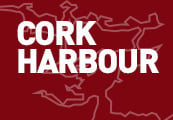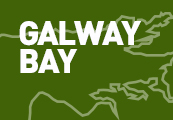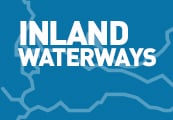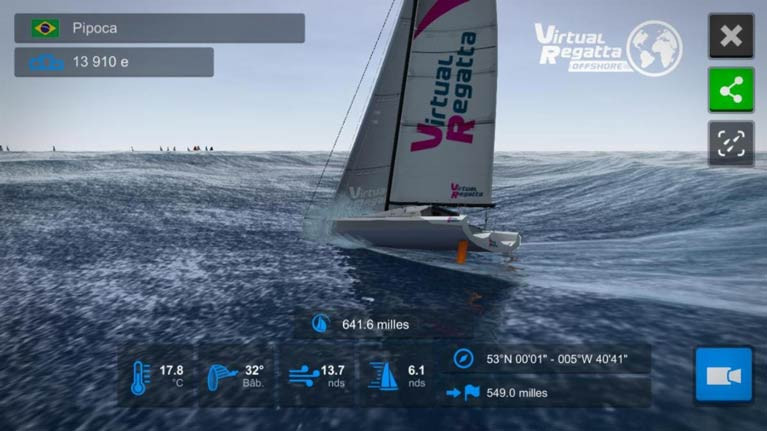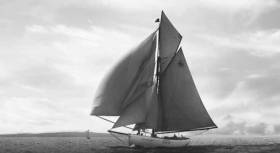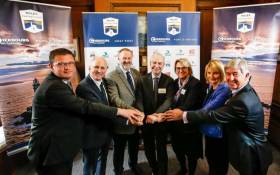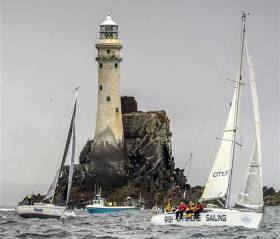Displaying items by tag: Fastnet Race
Battle Royal Over the Course for the Fastnet Race
It says everything about the iconic nature of the Royal Ocean Racing Club's Fastnet Race that a General Meeting about the route for the race, which should be a private matter among the admittedly many members of the RORC, has already become a matter of public discussion despite the announcement of the forthcoming AGM and EGM on December 7th being issued via email as recently as 00.00.45 on Saturday, November 14th.
The timing thereby avoided publication on a gloom-laden and fateful Friday 13th by just 45 seconds. But inevitably there has already been much turmoil and dissent among traditionalists who felt that the time-honoured Plymouth finish was an integral and essential part of the Fastnet experience. When the proposed Cherbourg finish was announced a year ago, the RORC officers, committee and executive pointed out that they felt that facilities at Plymouth no longer met the requirements of a very varied fleet approaching 400 boats, some of them very large.
But traditionalists pointed out that expecting Plymouth to be able to cope with such a demand for an event which occurred only once every two years was like expecting a household to be permanently prepared for Christmas lunch, and that a bit of crowding was inevitable.
 It may not be Monte Carlo, let alone Cherbourg, but packing them in at Plymouth after the Fastnet Race has always been an integral part of the Fastnet experience.
It may not be Monte Carlo, let alone Cherbourg, but packing them in at Plymouth after the Fastnet Race has always been an integral part of the Fastnet experience.
Nevertheless, it seemed that Cherbourg's offer of the sun, moon and the stars in terms of facilities had won the day. But apparently, a significant group of the grassroots members of the RORC think differently, and they've been quietly gathering their forces and under Club Rule 16.1, they've secured this EGM with the proposal, for decision by a simple majority of full members, that something as significant and central as the Fastnet Race course to the RORC's existence and ethos should be decided only by the agreement of the full membership, albeit through virtual voting under the current pandemic circumstances.
Interesting times. For a year, it has looked as though our own revered Fastnet Rock was going to be all that was left of the original Fastnet Race course. Between 1925 and 1947, it started eastward out of the Solent from the Royal Victoria YC at Ryde, the only exception being 1935 when it started westward from the Royal Solent YC at Yarmouth. But then in 1949 under the persuasion of John Illingworth, the Royal Yacht Squadron at Cowes took over starting duties for a westward-going start sequence which has now become one of global sailing's great wonders as they exit the Needles Channel in a vast panoply of sail with the full ebb roaring along under them.
 One of global sailing's great wonders – the Fastnet fleet beating westward through the Needles Channel.
One of global sailing's great wonders – the Fastnet fleet beating westward through the Needles Channel.
It is so much a part of sailing consciousness that modern sailors have assumed that's the way it has always been, but it hasn't. However, the rounding of the Fastnet Rock and the finish at the lighthouse on Plymouth Breakwater have always been an integral part of it all, particularly as the formation of a new organisation, the Ocean Racing Club which was to become the RORC in 1931, was successfully proposed at the post-race dinner in Plymouth’s Royal Western Yacht Club attended by all the crews of the seven yachts that had finished, including Harry Donegan’s Gull from Cork which had placed third. But in November 2019, the RORC's Flag Officers, Committee and Executive presented the change to Cherbourg as a fait accompli.
Quite so. It's now perfectly possible that this fait accompli will be overturned by force majeure on December 7th. Plus ca change. Mais c'est la vie. And now that the populist provocateur extraordinaire Dominic Cummings is at a loose end, this might be just the job for him. Sacre bleu…
 Fastnet Race course as it has been 1949-2019 (gold line), with the planned new finish to Cherbourg (red)
Fastnet Race course as it has been 1949-2019 (gold line), with the planned new finish to Cherbourg (red)
49th Rolex Fastnet Race - One Year to Go!
In one year’s time, a new era will begin for the world’s largest offshore yacht race. On 8 August 2021, the Rolex Fastnet Race will set sail from Cowes bound for the Fastnet Rock as usual, but then, once the boats have rounded Bishop Rock, they will, for the first time in the race’s 96 year history, point their bows towards Cherbourg, the new finish for the Royal Ocean Racing Club’s premier event.
Announced last November, the change in finish venue to Cherbourg comes thanks to the joint co-operation of the City of Cherbourg-en-Cotentin, the Communauté d’agglomération du Cotentin, the Conseil départemental de la Manche and Région Normandie with the event’s organiser, the RORC. The Rolex Fastnet Race’s giant fleet will face no berthing shortage when they reach Cherbourg where they will be moored in Port Chantereyne and the Bassin du Commerce.
Well used to hosting large sailing and other sports events, the historic naval port at the top of the Cotentin Peninsula, will provide shoreside spectacle and razzamatazz on an unprecedented scale for Rolex Fastnet Race finishers. Most unexpected for competitors from outside of France will be the degree of interest taken in yacht racing by the local community. Thanks to events such as the Vendée Globe and the Route du Rhum professional sailing is a top tier sport in France and its top players, many of whom will be competing in the Rolex Fastnet Race, are household names. In addition to its long history and its massive fleet, one of the attractions of the race, that draws competitors from across the globe, is the opportunity for not just the general offshore racing community, but also Corinthian family, friends and sailing school entries to be on the same start line as legends of our sport.
Among the stars will again be Charles Caudrelier and Franck Cammas on Maxi Edmond de Rothschild. The massive 32m long 23m wide flying trimaran is one of the world’s fastest offshore race boats and famously in the last race overtook Francois Gabart’s MACIF on the last gybe to win by less than a minute.
“It was a similar difference between Dongfeng Race Team and MAPFRE in the race before,” recalls Caudrelier, who went on to skipper the Chinese VO65 to victory in the subsequent Volvo Ocean Race. “I love the race because I think the south coast of England and the north coast of Brittany are most complicated to manage which makes them the best places for racing. I really enjoy the passage between Cowes and the Lizard playing the sea breeze and the current. The Rolex Fastnet Race is a mix between a coastal race and an offshore in the Irish Sea - it is very interesting.”
 Rolex Fastnet Race - the last three editions have seen record-breaking fleets Photo: Kurt Arrigo
Rolex Fastnet Race - the last three editions have seen record-breaking fleets Photo: Kurt Arrigo
Caudrelier is naturally pleased that the next edition will end in Cherbourg. He has raced in and out of there many times, most recently in the Drheam Cup which Maxi Edmond de Rothschild won. “It is a good place for racing - very tricky with a lot of current. Each time I’ve visited it was a nice place with great parties and people – I have a lot of good memories.”
It remains unconfirmed if 2019 Rolex Fastnet Race overall winner David and Peter Askew’s VO70 Wizard will return to defend their title, however, their sailing master, Volvo Ocean Race skipper Charlie Enright will be back, this time as skipper of 11th Hour Racing Team aboard his new generation IMOCA 60, that will be competing in The Ocean Race in 2022-23.
Enright is a fan of the Rolex Fastnet Race: “It is certainly one of the more complex races as from a course perspective it has so many different features and you never know what it is going to throw at you. Also, you can count on the competition year in year out - that makes it hard to win, so when you do it does feel good.”
Currently based in Concarneau, Enright appreciates what a difference the Cherbourg finish will make. “In France, they like their boating and the finish should be more spectacular I imagine.”
With the finish in Cherbourg, more French entries are anticipated but the majority are still likely to be from the UK. Last year David Collins was the top British finisher under IRC, his Botin IRC 52 Tala’s time correcting out to third overall behind Wizard and Nicolas Groleau’s Mach 45 Bretagne Telecom. Having come so close in 2019 and after not racing this season, Collins says the Rolex Fastnet Race will be Tala’s main event in 2021, in what will be a UK-only season.
CEO of the RORC, Eddie Warden Owen adds: “The coronavirus pandemic has left us already looking towards 2021 and a racing season - the highlight of which will be the 49th Rolex Fastnet Race.
“The last three editions have seen record-breaking fleets attracting enthusiastic amateurs, seasoned offshore racers as well as out-and-out professionals from all corners of the world, all captivated by the challenge of racing to the Fastnet Rock, battling the strong currents and headlands off the south coast of England, followed by the open ocean in the Celtic Sea, while enduring the changeable weather en route.
“For the 2021 and 2023 races the finish will be in Cherbourg and we are excited at working with our colleagues in France where offshore racing is a national sport and where competitors can expect a wonderful welcome and warm hospitality.”
Just over a year out from the August 2021 start of the race proper, potential competitors, armchair sailors and gamer enthusiasts from all over the world will have the opportunity to try their hand at competing on the new course for the Rolex Fastnet Race, in the online game created by Virtual Regatta.
The first part of the Royal Ocean Racing Club's premier offshore event remains the same - leaving Cowes, heading west down the English Channel, passing Land's End and crossing the Celtic Sea to the Fastnet Rock off southwest Ireland, before returning to the Channel, leaving Bishop Rock to port. But, for its next edition, the finish has moved to Cherbourg at the top of the Cotentin Peninsula, some 70 miles due south of Cowes. This change to the world's most popular offshore race increases its distance to 695nm.
Following the new course, Virtual Regatta's Rolex Fastnet Race will set sail at 1200 UTC on 3 August 2020. It will provide players with the opportunity to compete against friends, family, colleagues or fellow sailing enthusiasts in a race based on real weather data aboard their own Class40. The game is free to play, but the more competitive can pay a small fee to upgrade their equipment. While the 'real' Rolex Fastnet Race is the world's most well-subscribed offshore race with more than 350 entries expected on the start line in 2021, ranging from 100ft Ultime maxi trimarans to mums and dads on their 30ft family cruisers, the Virtual Regatta fleet will dwarf this, their offshore events regularly seeing more than 30,000 entries.
Among the virtual competitors, this year will be two-time Volvo Ocean Race winner Phil Harmer. The Australian was part of Ian Walker's crew that set the present monohull Rolex Fastnet Race course record aboard the VO70 Abu Dhabi Ocean Racing in 2011. Despite his vast offshore experience and having competed in at least six Rolex Fastnet Races, Harmer is new to Virtual Regatta offshore events. "When lockdown started I downloaded the app and played a few dinghy races, but I haven't done any offshores. There's nothing like a Fastnet for a baptism of fire! It will be fun to do. It will keep me busy."
Harmer will be competing from his base in Sydney where his night shift will be made easier as he will be up, in any case, tending his newborn child. He is looking forward to going to Cherbourg. "Sometimes things just need a little change to get people interested in doing it again."
Former RORC Commodore and Admiral Andrew McIrvine intend to race his new La Réponse, a Ker 39, in next year's Rolex Fastnet Race. He advises that the Virtual Regatta race will provide a good opportunity to walk the course: "This course will be a new challenge for all of us - even those who have done more than enough Fastnets! It will be good to try it out 'virtually'. A number of friends and I have been having fun doing VR races during lockdown. Planning the weather routing is remarkably realistic and educational - highly recommended for budding navigators!"
Also on the virtual Rolex Fastnet Race start line will be Sonar world champion Hannah Stodel, who has her sights set on competing in the new mixed doublehanded offshore class for the Paris 2024 Olympics. "I've done a couple of Virtual Regatta races for fun, but nothing like the Fastnet," she says. The virtual Rolex Fastnet Race will have the benefit that it will be sailed in Class40s, the class in which Stodel had been hoping to compete this season. She is looking to do the virtual race with some of her crew who sailed the real Rolex Fastnet Race previously. "They are quite excited about it and there's even talk of a watch system. Anything that gets you looking at weather data and making strategic decisions is good practice, even if it is on the computer. It'll be a learning experience."
The virtual Rolex Fastnet Race can be played on a computer at: (www.virtualregatta.com) and on a smartphone via the Virtual Regatta Offshore App available for download from the Apple Store / Google Play Store. Those wishing to play must register with Virtual Regatta.
Notice Of Race For SCORA Fastnet Race Now Available
The Notice of Race for the 2020 SCORA Fastnet Race, sponsored by UK Sailmakers Ireland, is now available to download.
No class divisions apply in this all-in IRC race, which sets off from the Kinsale Yacht Club’s Charles Fort Line with first gun at 5.55pm on Saturday 1 August. For more see the NOR attached below.
The run to the Fastnet, as noted in Tom MacSweeney's podcast earlier today, will be the highlight of a weekend of sailing in Kinsale that also includes the Open Keelboat Regatta, sponsored by Barry Ryan Civil Engineering Ltd.
This one-design for regatta is open to Dragons and Squibs, with six races over two days outside of Kinsale Harbour and an entry fee of just €40.
See the Kinsale Yacht Club website for further details including entry forms and sailing instructions.
One big overall win has eluded Northern Ireland navigator Ian Moore - in nine attempts at the Rolex Fastnet Race Moore’s team has made the podium twice but failed to win the Royal Ocean Racing Club’s flagship race. Ian is fascinated by the Fastnet Race and is a leading expert on offshore racing tactics and strategy. He analyses the new route, giving expert advice on the nuances of the famous offshore classic scheduled to start on August 8th, 2021.
Moore hails from Carrickfergus but has lived in Cowes, Isle of Wight for many years.
As a navigator, Ian has a highly impressive record with big event wins literally running off the page: Volvo Ocean Race, Transatlantic Race, Rolex Sydney Hobart, Newport Bermuda Race, RORC Caribbean 600, Transpac, Rolex Middle Sea Race, Rolex Giraglia, HK Vietnam Race, and Round Ireland.
The live interview (below) with Louay Habib include stories, pictures and the 2021 Rolex Fastnet course.
The Fastnet Race Centenary is in Five Years – How Well Has Ireland Scored Since 1925?
In 2025, the Centenary of the RORC Fastnet Race – arguably the world’s most famous offshore challenge – will be sailed. Until recently, it would have seemed a bit odd to be focusing on a Centenary all of five years hence. But we now live in very strange times, and the current lockdown with multiple cancellations and postponements of unknowable length means that at some time in the future – maybe even further into the future than we dare to think – there will still be a log-jam of international events trying to find their place in the sun in order to get a regatta and a result, while the previously-established world sailing programme will hit more than a few bumpy patches as it tries to regain its regular rhythm.
Centenary Fastnet Race
In these circumstances, there’s no doubting that the Centenary Fastnet Race is a quintessential pillar event, a happening of such European and international significance that other fixtures should unquestioningly cede precedence to it. And the Centenary Fastnet Race to which they should cede precedence in 2025 ought to be on the best-known and most-frequently-sailed course, from Cowes down Channel and northwest to the Fastnet Rock, and then southeast leaving the Isles of Scilly to port, and on to the finish at Plymouth - 608 miles in all.
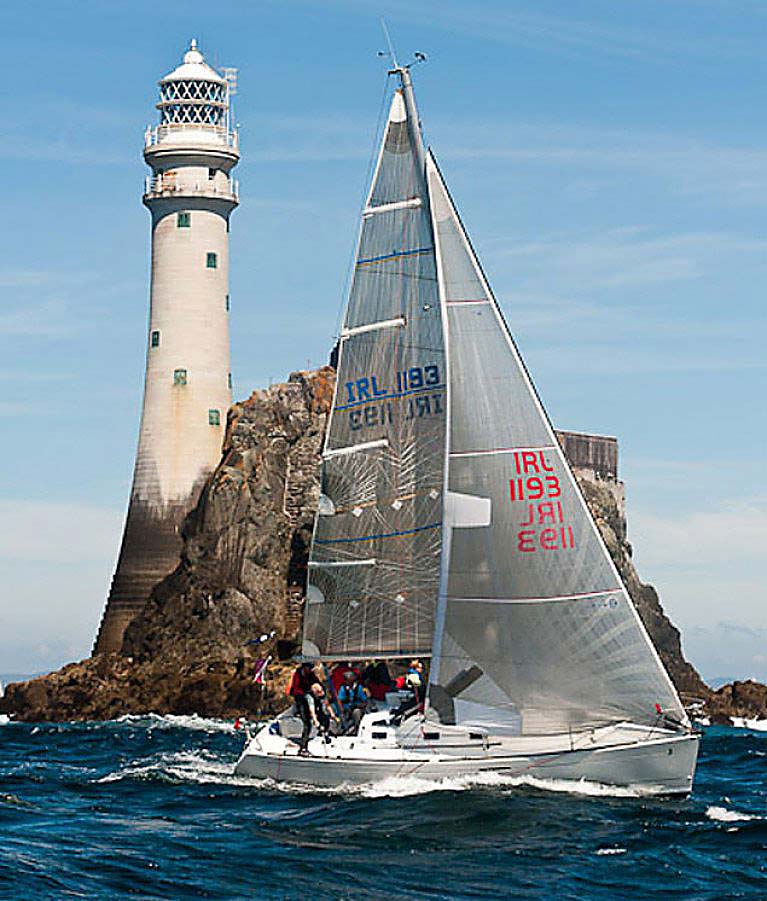 The Fastnet Rock is the only constant in the changing history of the Fastnet Race. Photo: Robert Bateman
The Fastnet Rock is the only constant in the changing history of the Fastnet Race. Photo: Robert Bateman
New Cowes-Fastnet-Cherbourg course
Although the Fastnet Races of 2021 and 2023 will use the new Cowes-Fastnet-Cherbourg course, it has been hinted that for historic 2025, this time-honoured course from Cowes to the Fastnet and thence to Plymouth will be resumed. But as it happens, it’s not the original course. The first Fastnet in 1925 started from the Royal Victoria YC at Ryde on the northeast coast of the Isle of Wight, and exited the Solent eastward, leaving the Isle of Wight to starboard before heading for the Fastnet Rock and then back to Plymouth. This was sailed annually from 1925 until 1931, after which the race became biennial. But the same course was retained except for 1935, when it started in the Western Solent and sent the fleet directly westwards from the Royal Solent YC at Yarmouth on the Isle of Wight.
The old course was resumed in 1937 and 1939, then after losing three races to World War II from 1939 to 1945, 1947’s race saw it resumed from the Eastern Solent. But with shoreside facilities problems in the immediate post-war period, that 1947 Royal Victoria YC start was provided from Portsmouth with assistance from the Royal Navy. Then in 1949, the start from the Royal Yacht Squadron at Cowes - with the fleet going westward - was introduced, and the Fastnet Race as virtually everyone today has known it was born.
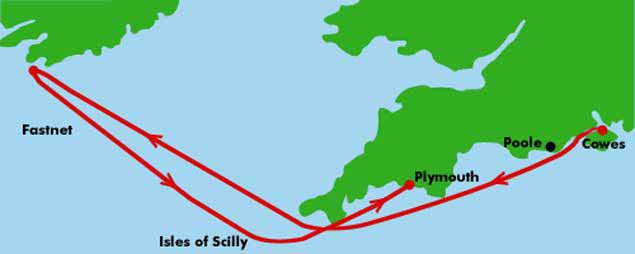 The “traditional” Fastnet Race course has only been sailed between 1949 and 2019, with three different start ports being used – with Ryde on the Isle of Wight the most frequent – before Cowes became the start point in 1949.
The “traditional” Fastnet Race course has only been sailed between 1949 and 2019, with three different start ports being used – with Ryde on the Isle of Wight the most frequent – before Cowes became the start point in 1949.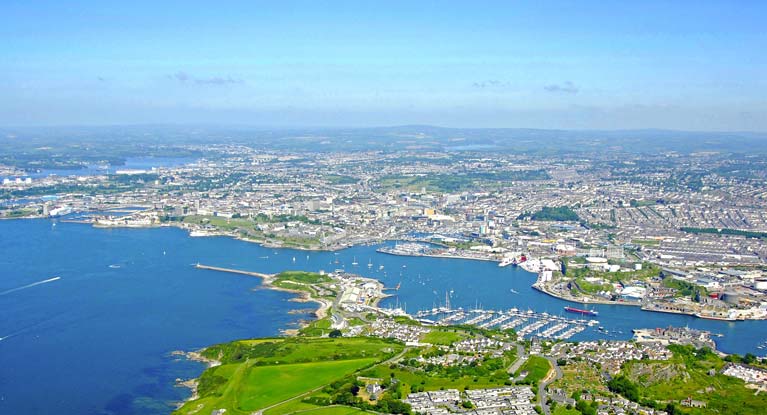 The port of Plymouth. While Cherbourg may have been indicated as the finish port for the Fastnet Races of 2021 and 2023, until now Plymouth has been the port most totally associated with the race. It wasn’t until 1949 – 24 years after it was first raced – that the Fastnet Race finally started from Cowes, but between 1925 and 2019, the race always finished in Plymouth.
The port of Plymouth. While Cherbourg may have been indicated as the finish port for the Fastnet Races of 2021 and 2023, until now Plymouth has been the port most totally associated with the race. It wasn’t until 1949 – 24 years after it was first raced – that the Fastnet Race finally started from Cowes, but between 1925 and 2019, the race always finished in Plymouth.
Overall Fastnet wins
Ireland’s successes in the Race over the years since its inception in 1925 have been distinctive, even if they aren’t numerous. But then, proportionately speaking, how many overall Fastnet wins should a country with our sailing population expect to achieve?
For there’s no doubt that enthusiastic national numbers with good boats and a strong success ethic throughout the crews will show in the results, as has been seen in recent years with the overall handicap winner table being dominated by the French. But then, just a couple of the more popular Breton sailing ports would have more boats between them than you’ll find in all Ireland, and the modern French offshore racing tradition, built on the well-earned hero-worship of Eric Tabarly and his successors, has solid foundations with achievements which are manifested in many ways.
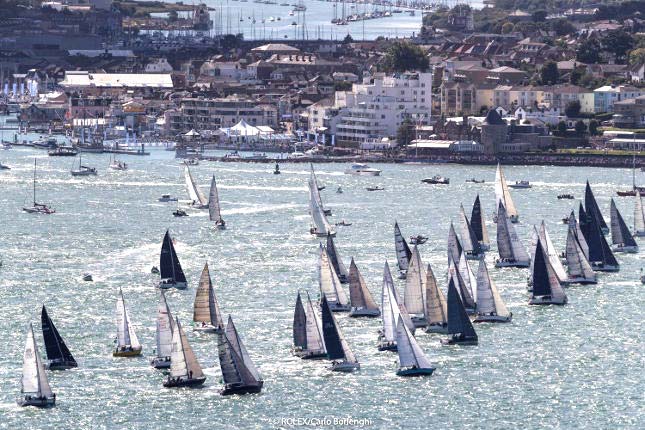 With a total fleet pushing towards the 400 mark, getting the contemporary Rolex Fastnet Race under way at Cowes is a continuous process of many class starts. Photo: Rolex/Carlo Borlenghi
With a total fleet pushing towards the 400 mark, getting the contemporary Rolex Fastnet Race under way at Cowes is a continuous process of many class starts. Photo: Rolex/Carlo Borlenghi
Harry Donegan’s Gull
Our own focus is inevitably narrower, but when we remember that one of the seven boats in the original Fastnet was Harry Donegan’s Gull out of Cork and that the Corkmen were leading the fleet going past Land’s End when outward bound for the Rock - even if they were third at the finish in Plymouth – suggests that Ireland may actually have punched above her weight, for the period of 1920 to 1960 was one of relatively low activity in Irish offshore racing.
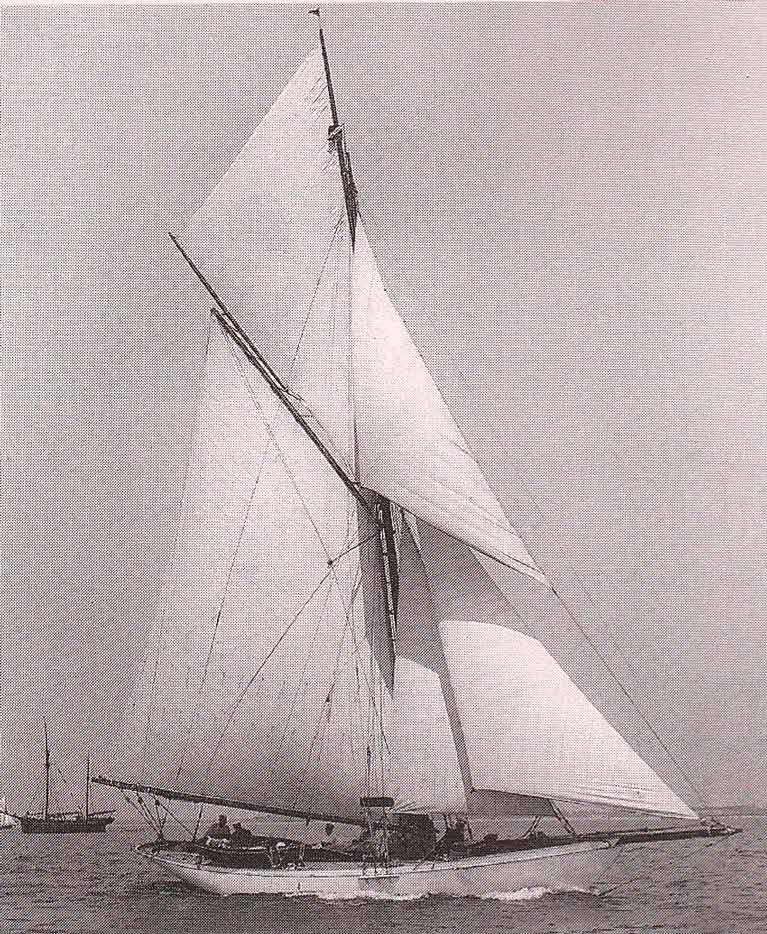 Harry Donegan’s Gull at the start of the first Fastnet Race from Ryde on the Isle of Wight in 1925. A17-ton gaff cutter designed by Charles E Nicholson and built by Camper & Nicholson in 1898, Gull was obliged under the rules of the new race to carry an adequate dinghy, which in this instance was kept upright on the starboard deck “as it was very handy for stowing gear”
Harry Donegan’s Gull at the start of the first Fastnet Race from Ryde on the Isle of Wight in 1925. A17-ton gaff cutter designed by Charles E Nicholson and built by Camper & Nicholson in 1898, Gull was obliged under the rules of the new race to carry an adequate dinghy, which in this instance was kept upright on the starboard deck “as it was very handy for stowing gear”
 Aboard Gull, driving hard during the first Fastnet Race in 1925. There were no rules requiring her to be fitted with guard rails, so she didn’t have them as they were considered “rather unsightly”.
Aboard Gull, driving hard during the first Fastnet Race in 1925. There were no rules requiring her to be fitted with guard rails, so she didn’t have them as they were considered “rather unsightly”.
That said, in 1947 Billy Mooney’s 42ft ketch Aideen out of Dun Laoghaire won her class in the 1947 Fastnet, as did Frank & Eric Hopkirk’s venerable cutter Glance from Belfast Lough in the race of 1953. But it has to be admitted that these wins were in numerically small divisions, and it wasn’t until the 1960s that Irish participation became more frequent.
By this stage, the Admiral's Cup was central to much of it, and it was a member of the 1971 team, Rory O’Hanlon’s S&S 43 Clarion from Dun Laoghaire Harbour, which went into the record books by winning the Philip Whitehead Cup, while the growth in the number of smaller boats was reflected in Ronnie Wayte taking second in the very large Class IV in that 1971 race in his new Hustler 35 Setanta of Skerries, which is currently – 49 years later - on the strength of the National YC in Dun Laoghaire.
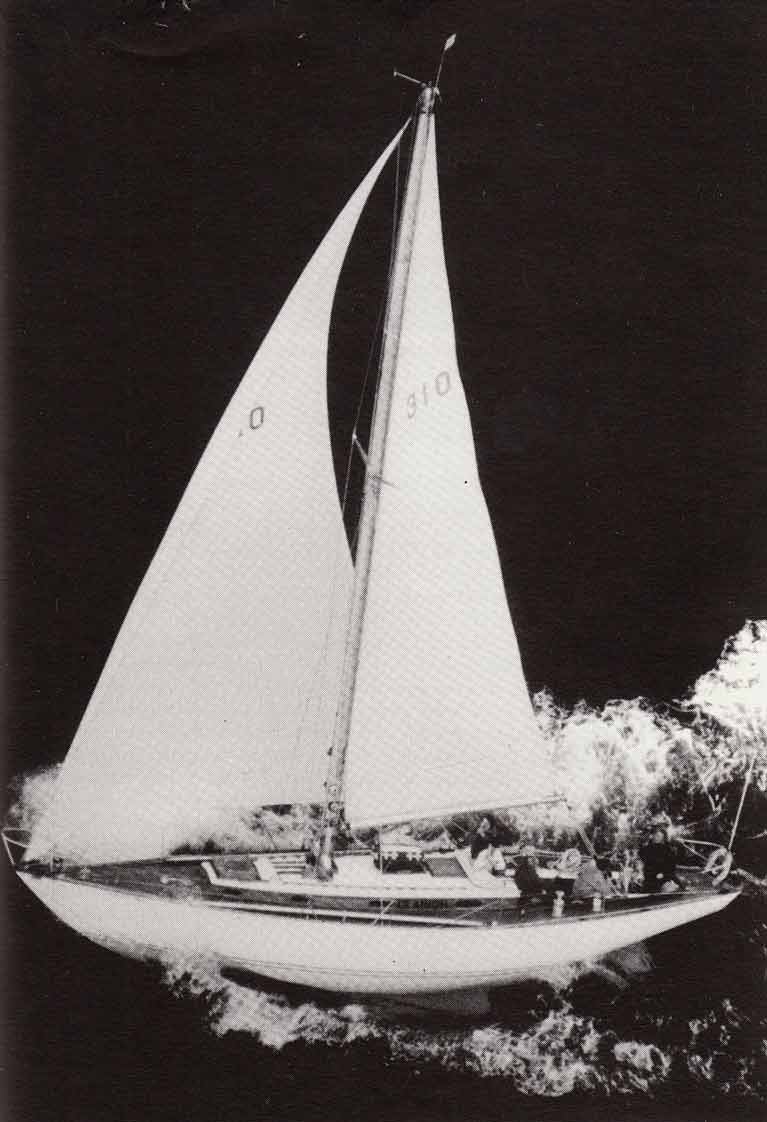 The classic 43ft Sparkman & Stephens Clarion (Dr Rory O’Hanlon RStGYC) during the 1971 Fastnet Race, in which she won the Philip Whitehead Cup
The classic 43ft Sparkman & Stephens Clarion (Dr Rory O’Hanlon RStGYC) during the 1971 Fastnet Race, in which she won the Philip Whitehead Cup
Fastnet Storm of 1979
Through the 1970s the pace built up, and in 1979 Ireland dominated the first stages of the Admiral's Cup, while in the first couple of hundred miles of the Fastnet Race itself, the betting was on as to whether Ken Rohan’s Holland 39 Regardless or Hugh Coveney’s Holland 43 Golden Apple would be the overall winner. But the Fastnet Storm of 1979 and the loss of both their rudders put paid to that high hope.
 Ken Rohan’s Holland 39 Regardless during the Irish Admirals Cup Trials at Cork, May 1981. With a crew built around Robert Dix, Drewry Pearson and Des Cummins, Regardless went on to be the top Admiral's Cup boat in the 1981 Fastnet Race. Photo: W M Nixon
Ken Rohan’s Holland 39 Regardless during the Irish Admirals Cup Trials at Cork, May 1981. With a crew built around Robert Dix, Drewry Pearson and Des Cummins, Regardless went on to be the top Admiral's Cup boat in the 1981 Fastnet Race. Photo: W M Nixon
Regardless
However, with a fresh crew including Young Turks like Robert Dix, Drewry Pearson and Des Cummins, Regardless was back for more in the 1981 Fastnet to achieve the best Irish result until then, the win in Class 1 and the overall win among all Admirals Cup boats.
They’re a talented trio, as Robert Dix – aka Dixie – had been the youngest ever All-Ireland Champion Helm at the age of 17 in October 1970 when the Helmsmans Championship – raced that year in National 18s – was the culmination of the Royal Cork’s Quarter Millennial celebrations. And ten years later, the trio were very much in action piloting Bruce Lyster’s eccentric Half Tonner Swuzzlebubble to overall victory in the 1980 ISORA Championship.
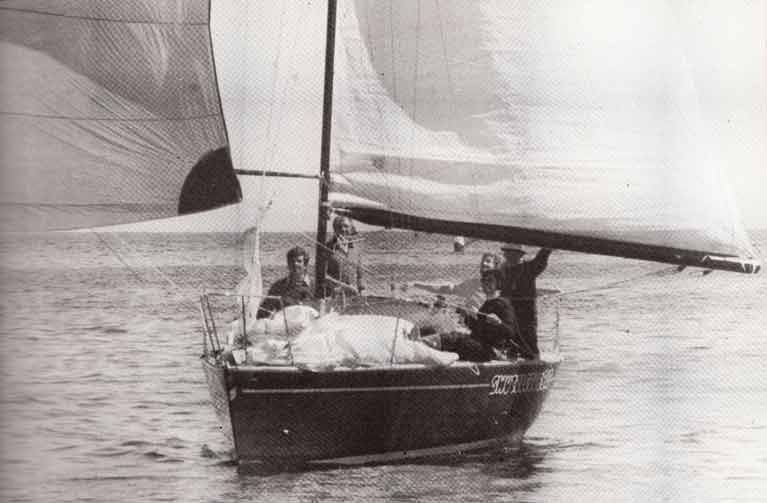 Bruce Lyster (left) on his originally-centreboard Half Tonner Swuzzlebubble coming in to win the Pwllheli-Howth Race of August 1980 - and the 1980 ISORA Championship with it - his crew including Robert Dix, Drewry Pearson and Des Cummins. Photo: W M Nixon
Bruce Lyster (left) on his originally-centreboard Half Tonner Swuzzlebubble coming in to win the Pwllheli-Howth Race of August 1980 - and the 1980 ISORA Championship with it - his crew including Robert Dix, Drewry Pearson and Des Cummins. Photo: W M Nixon
Admiral's Cup
Then came 1981, when the Admiral's Cup was arguably at its peak, so the Fastnet performance of Regardless was internationally acknowledged as something very special indeed. It certainly strengthened the already strong bond between the three guys, a bond which continues today in their joint ownership of the Hallberg Rassy 48 Alpaire of 2009 vintage, a particularly attractive Frers design in which they’ve recently been cruising the Black Sea.
But meanwhile, their performance with Regardless in 1981 had shown that clearly, the Big One was within sight, and in 1987 Ireland finally got the overall Fastnet Race win. Well, sort of…….
Thirty-three years ago, the growth of sponsorship in sailing could result in a confusion of results if rules from the era of total Corinthian participation were applied with precise regard for the last letter of the law. Thus although there were many sponsored entries racing in national teams in 1987’s highly competitive Admiral’s Cup for which the Fastnet Race was the climax, the peculiar reality was that none of them was eligible – because of being sponsored – to win the Fastnet Challenge Cup for the overall winner.
With a record fleet lining up for the Fastnet Race itself, and with thirteen teams competing with ferocious enthusiasm for the Admiral’s Cup in the best series for several years, it was so hectic in Cowes that the thought of an acute results problem arising in Plymouth after the Fastnet Race had finished does not seem to have been on the radar. Yet this is precisely what happened, and needless to say it was an Irish boat which was right at the eye of the storm.
Stephen Fein’s Dubois 40 Full Pelt was a late addition to the Irish Admiral’s Cup team. Skipper Tom Power of Dun Laoghaire had found that the boat he had originally chartered came with intractable rating problems. But in being forced into relatively last-minute negotiations with Full Pelt, the Irish fell on their feet.
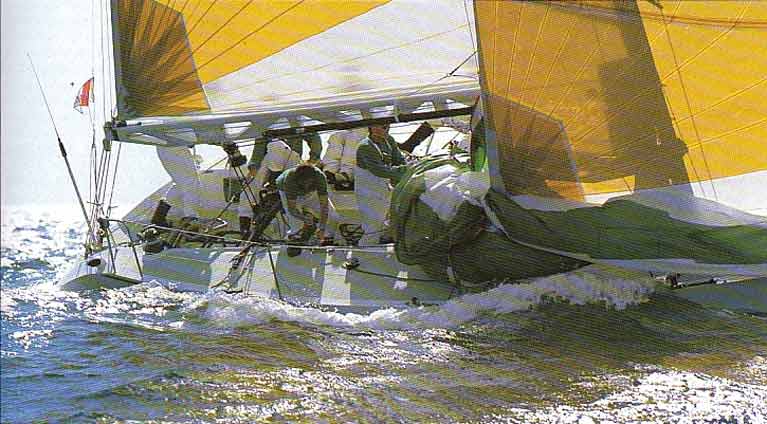 All systems go. The Dubois 40 Irish Independent racing in the 1987 Admirals Cup, Tim Goodbody is on the helm
All systems go. The Dubois 40 Irish Independent racing in the 1987 Admirals Cup, Tim Goodbody is on the helm
Full Pelt was the result of a dynamic linkup between owner Stephen Fein, his ace boat optimizer and tuner Jo Richards, and designer Ed Dubois. Yet despite being a boat which was clearly showing further potential with every outing, Full Pelt had yet to find a guaranteed team place as the Admiral's Cup moved up the agenda.
Negotiations took place with some urgency. With the support of non-sailing Team Captain Sean Flood, sponsorship was secured from the Irish Independent newspaper, and the delicate task of balancing a crew panel between Full Pelt’s core crew and Tom Power’s own talented squad – which included helmsman Tim Goodbody – was set in train. With generous give and take on both sides, a real team spirit emerged, and as the 1987 Admirals Cup got under way, it was clear that Irish Independent was very much a boat to be taken seriously, with Tim Goodbody proving to be the equal and sometimes the better of international helming superstars like Lawrie Smith.
 The crew of 1987 Fastnet Race winner Irish Independent at the Royal Irish YC on 2nd December 2016 were (left to right) Billy Pope, Tom Power, Jo Richards, Stephen Fein, Sean Flood (Team Captain), Tim Goodbody, Tom Roche and Graham Deegan. Photo: W M Nixon
The crew of 1987 Fastnet Race winner Irish Independent at the Royal Irish YC on 2nd December 2016 were (left to right) Billy Pope, Tom Power, Jo Richards, Stephen Fein, Sean Flood (Team Captain), Tim Goodbody, Tom Roche and Graham Deegan. Photo: W M Nixon
The Fastnet Race itself was a classic. In those days the big race started on the Saturday, and Irish Independent was very much in contention overall as she rounded the rock on the Monday evening. Then with the wind freshening wetly from the west, progress was rapid towards the finish at Plymouth, with the 40-footers finishing in a bunch around 0300hrs on the Wednesday morning.
This closeness of finish was exactly as Jo Richards had anticipated, and thus he had always been focused on keeping Irish Independent/Full Pelt’s rating a point or two below comparable boats. This meant that while the Richard Burrows-skippered Dubois 40 Jameson Whiskey rated 1.0195, Irish Independent clocked in at 1.0188. As often as not, Irish Independent would be ahead on the water anyway, but there was always this tiny ratings gap to fall back on, something which increased in significance with longer races and particularly with the Fastnet.
So on that wet pre-dawn Wednesday morning, Irish Independent was already well launched on her way to being declared overall winner of the Fastnet Race. And in a broadening of the scope of Irish success, it soon became clear that the legendary Holland 39 Imp, raced as a veteran by Roy Dickson of Howth, was also going to win the Philip Whitehead Cup. But in the euphoria of these achievements, it took a while before it was fully realised that despite the clarity of Irish Independent’s victory, there was no way she was going to win the coveted Fastnet Challenge Cup. That would go to the top-placed non-sponsored boat.
In the end, the band of brothers which had emerged from the melding of two crews aboard Irish Independent/Full Pelt had to be content with receiving a little silver dish – “a leprechaun’s hub-cap” as Tom Power described it – as the only acknowledgement of what they had done.
While everyone knew what the real situation was, the fact that the official records stated otherwise tended to obscure the facts with every passing year, and the untimely death early in 2016 of designer Ed Dubois – who had been an active crew member on the boat during the Fastnet Race – was a reminder that something needed to be done to put things in proper perspective.
Friday, December 2nd 2016 would normally have been a day on which people started seriously anticipating Christmas. But for those for whom Irish Independent/Full Pelt was a very special boat at the centre of an unusual but successful crew-merging project, Friday, December 2nd 2016 was the day on which the then Commodore of RORC, Michael Boyd, and the 1987 skipper of Irish Independent, the late Tom Power, jointly hosted a lunch in the Royal Irish Yacht Club in Dun Laoghaire to honour the memory of Ed Dubois and to celebrate the sportsmanship and goodwill of Stephen Fein and Jo Richards in throwing themselves so completely into campaigning with a crew of Irish strangers who had become close friends by the time the series was completed.
 Janet Grosvenor of the RORC and Graham Deegan, a crewmember on Irish Independent in 1987, in the RIYC December 2016. Photo: W M Nixon
Janet Grosvenor of the RORC and Graham Deegan, a crewmember on Irish Independent in 1987, in the RIYC December 2016. Photo: W M Nixon
An official stamp of approval was put on it all by the welcome presence of Janet Grosvenor, Assistant Secretary at the RORC in 1987, and key administrator of the Admiral's Cup, who has since been properly recognized for her great services over very many years to offshore racing by being conferred with Honorary Membership of the RORC. And thanks to links with Irish Lights, a new trophy – made from a prism from the light on the Fastnet Rock – was presented to Stephen Fein and Tom Power, acknowledging the boat’s clear overall win and complete with the names of the crew.
As for the full supporting cast at that lunch of 2016, it was extraordinary, as it included both the 1987 Team Captain Sean Flood, and the Team Manager Terry Johnson, it also included former RORC Commodore John Bourke who was navigator of Jameson Whiskey back in 1987, and it numbered almost the entire crew panel for Irish Independent/Full Pelt, including those who had sailed some of the races, and those who had stood aside to allow the core squad to race the boat round the Fastnet.
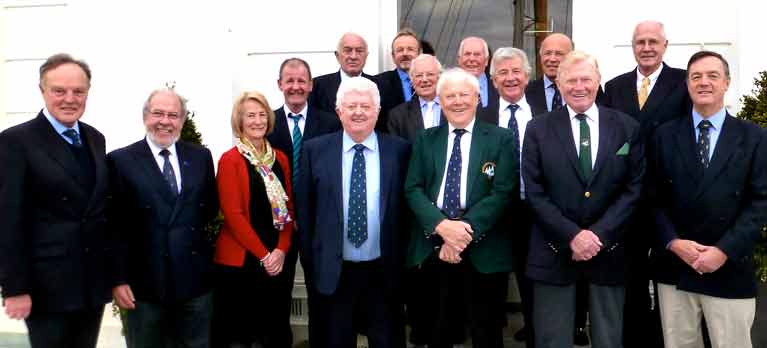 Putting the record straight. Among those who gathered at the RIYC in December 2016 to put the record straight on the real winner of the 1987 Fastnet Race were (left to right) Michael Boyd (Commodore RORC), Jim Horan (Commodore RIYC), Janet Grosvenor (RORC), Billy Pope (Irish Independent crew), Tom Power (Irish Independent skipper), Michael O’Leary (Fastnet contender), Jo Richards (Irish Independent designer/tactician), Stephen Fein (owner Full Pelt/Irish Independent), Terry Johnson (1987 Irish Admirals Cup Team Manager, Sean Flood (1987 Irish Admirals Cup Team Captain), Tom Roche (Skipper 1987 Irish Team Mumm 36), Tim Goodbody (Irish Independent helm), John Bourke (former Commodore RORC and navigator on 1987 Irish Team Dubois 40 Jameson), Graham Deegan (Irish Independent crew) and Paddy Boyd (Fastnet contender). Photo: W M Nixon
Putting the record straight. Among those who gathered at the RIYC in December 2016 to put the record straight on the real winner of the 1987 Fastnet Race were (left to right) Michael Boyd (Commodore RORC), Jim Horan (Commodore RIYC), Janet Grosvenor (RORC), Billy Pope (Irish Independent crew), Tom Power (Irish Independent skipper), Michael O’Leary (Fastnet contender), Jo Richards (Irish Independent designer/tactician), Stephen Fein (owner Full Pelt/Irish Independent), Terry Johnson (1987 Irish Admirals Cup Team Manager, Sean Flood (1987 Irish Admirals Cup Team Captain), Tom Roche (Skipper 1987 Irish Team Mumm 36), Tim Goodbody (Irish Independent helm), John Bourke (former Commodore RORC and navigator on 1987 Irish Team Dubois 40 Jameson), Graham Deegan (Irish Independent crew) and Paddy Boyd (Fastnet contender). Photo: W M Nixon
But although the question of just who really did win the 1987 Fastnet Race was finally resolved in a roundabout sort of way in Dun Laoghaire 29 years later, back in the late 1980s the amateur/professional/sponsorship thing was a conundrum which rumbled on for quite a while. Thus in Jamie Young’s article earlier this week about using eco-friendly auxiliary sail power for cargo and passenger-carrying commercial vessel, we mentioned in our intro that his West Coast-based Expedition Yacht, the Frers 49 Killlary Flyer, had been overall winner of the 1988 Round Ireland Race.
Well, this is true up to a point. But in 1988, Round Ireland Race Director Michael Jones of Wicklow was ultra-scrupulous in implementing the amateur/professional/sponsorship directives. And in those days, Killary Flyer was Brian Buchanan’s Hesperia from Belfast Lough. Yet she did the 1988 Round Ireland as Woodchester Challenger in a well-sponsored deal arranged by Liam Lawlor of Howth with support from the Dublin-based finance company, but skippered as usual by Dickie Gomes, who sailed with most of his regular crew.
Yet as far as Michael Jones was concerned, the sponsorship made the boat a completely different animal, and she could only race in the Channel Handicap Division, whereas all the main prizes were still being allocated in the International Offshore Rule division. It’s small consolation that the IOR was soon to be replaced with Channel Handicap’s offspring, the IRC, for in 1988 Dickie Gomes and his crew sailed the race of their lives round Ireland to be challenging Hesperia/Woodchester’s slightly bigger sister, Denis Doyle’s Moonduster, at every corner before coming home to a strong finish at Wicklow.
When the results became official, Woodchester may have won overall under CHS from Liam Shanahan’s db2S Lightning from the National YC. But in IOR among the proper silverware, Lightning was the winner by three hours from Tony Vernon’s 40-footer Canterbury from Abersoch with Moonduster third, while Woodchester Challenger was simply nowhere in every way, for as far as the IOR Division was concerned, she simply didn’t exist.
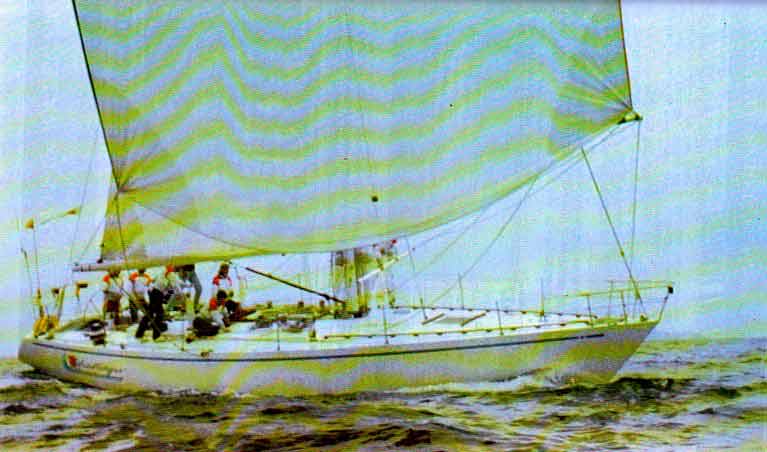 One of German Frers most attractive designs, this Frers 49 started life as Ron Amey’s Noryema XI. She then became Brian Buchanan’s Hesperia, while for the 1988 Round Ireland Race she was – as seen here – Woodchester Challenger, and these days she is Jamie Young’s Killary Flyer, the noted Arctic Expedition Yacht based in northwest Galway.
One of German Frers most attractive designs, this Frers 49 started life as Ron Amey’s Noryema XI. She then became Brian Buchanan’s Hesperia, while for the 1988 Round Ireland Race she was – as seen here – Woodchester Challenger, and these days she is Jamie Young’s Killary Flyer, the noted Arctic Expedition Yacht based in northwest Galway.
Yet in the special camaraderie which prevails at the end of a Round Ireland Race, the attitude seemed to be that we were getting two good winners for the price of one. Lightning’s win was deservedly popular, and remains so today, for the Shanahan family have now been making a massive contribution to Irish offshore racing for three generations. And Woodhester Challenger's race had been one of those flawless performances which falls rarely to anyone, and are cherished for their own sake.
But there’s a certain irony in the fact that for the next Round Ireland in 1990, a huge affair with a significant Maxi presence, all the old rules and reservations about commercial sponsorship of entries had been chucked out with total abandon. Absolutely everyone was in with a chance at all the main prizes, and the line honours winner and fully acknowledged overall winner was Lawrie Smith – with his crew including Gordon Maguire - racing the Maxi Rothmans, a sponsorship which would be seen these days as so toxic that the boat probably wouldn’t even be allowed into Irish territorial waters.
Meanwhile back at the Fastnet Race, with the absence of Moonduster after the deathn at the age of 81 of Denis Doyle in 2001, it fell to several boats to take on the mantle of Irish representation. And they did it very well, for although The Duster had been a regular entrant and in the Fastnet class frame at times, stellar results eluded her. But when another Crosshaven boat, Eric Lisson’s Noray 38 Cavatina - which was already well-known as a Round Ireland success - took on the Fastnet challenge in 2005, she came within 23 minutes of winning the Fastnet Challenge Cup.
Sailing in Class 3, they’d a race-long ding-dong with the slightly lower-rated Nicholson 33 Iromiguy (Jean-Yves Chateau). There was an unusually large amount of spinnaker work, and Eric Lisson recalls how as night drew on they’d see the all-too-familiar spinnaker of Iromiguy fading into the dark astern, then through the night they’d have that familiar impression of sailing so well that they were convinced they were dropping the Frenchmen. But as sure as God made little apples, as the dawn came up one of the sets of navigation lights astern would be revealed as having that damned Iromiguy spinnaker setting sweetly aloft.
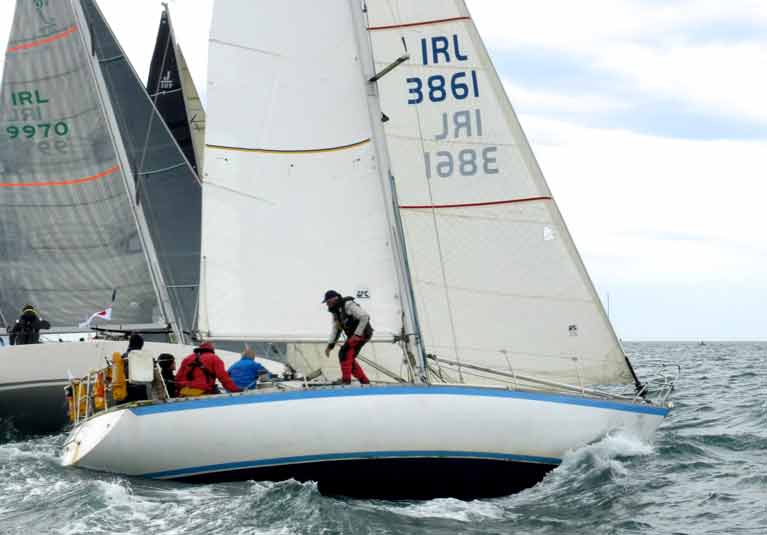 A boat and crew in harmony – Cavatina and her team came second overall (by 23 minutes) in the 2005 Fastnet Race, and won their Class in the race of 2007. Photo: W M Nixon
A boat and crew in harmony – Cavatina and her team came second overall (by 23 minutes) in the 2005 Fastnet Race, and won their Class in the race of 2007. Photo: W M Nixon
So at the finish Iromiguy had the class win by 23 minutes from Cavatina, and as the numbers overall fell the right way for boats of Class Three, Iromiguy had the Fastnet overall win too. It was the third Fastnet Challenge Cup win for Cork-based designer Ron Holland, as Iromiguy’s sister-ship Golden Delicious had won overall in 1975, while Dave Allen Holland 39 Imp won in 1977. Yet that was only small consolation for Cavatina’s all-amateur crew, to be so near and yet so far, even if the vast majority of offshore racers could not conceive of the wonder of coming second overall in a Fastnet Race.
Eric Lisson and longtime shipmate Dave Hennessy (who was subsequently to complete a four year global circumnavigation in his own boat Laragh) were to have considerable consolation in 2007 when they raced Cavatina in the AZAB and won overall against opposition including Jamie Young’s Frers 49 Killlary Flyer from Galway. Buoyed up by this success, Cavatina then went on to do the 2007 Fastnet Race in which, this time round, they got the class win. But overall it wasn’t Class 3’s race, yet with Cavatina’s class win and another noted success, 2007 was arguably Ireland’s best Fastnet Race to date.
For it was the race of 2007 – all of twenty years after Irish Independent’s win – which secured the overall win again, and this time the Fastnet Challenge Cup came with it with no equivocation.
For this was the year of Ger O’Rourke’s Cookson 50 Chieftain from the Royal Western Yacht Club of Ireland in Kilrush. The Limerick skipper had his own way of doing things, such there were factors around Chieftain’s win which made it an epochal achievement in the purest if sometimes a rather crazy spirit of Irish offshore racing.
For a start, Ger O’Rourke – who’d already taken a class win and fourth overall in the Sydney-Hobart Race when his boat was still fresh from the builders in New Zealand – had a superstition about not officially entering Chieftain for the next big race on her outline programme until she had completed the one in which she was currently involved. In 2007, she raced the New York to Hamburg Race, taking second. But it was only once she was in Hamburg in late June that Ger got in touch with the RORC about the Fastnet, to be told that they’d take his entry, but he’d be 46th on the waiting list as the 2007 Fastnet Race had long since been over-subscribed.
It sounds daft, but there hadn’t been a real gale in open water in the Fastnet Race since the mega-storm of the 1979 disaster, and people were still nervous of its memory. Thus the RORC office were confident that there’d be a lot of drop-outs as the 2007 race approached, as it was a very unsettled summer. They were right, with Chieftain moving up the waiting list so rapidly that Ger considered it worth his while to position his boat in the Solent, where by the Tuesday before the race on Sunday, he was told he was now highly likely, and his full entry was confirmed on the Thursday.
As it happened, he’d four days to the start, for though it had been planned for the Sunday, a short sharp severe storm zapping up the English Channel saw it being postponed 25 hours until the Monday, which didn’t help the jitteriness of many crews. But Chieftain’s team were made of sterner stuff, and on Monday there she was, confidently thumping her way to windward down the Solent in the midst of the Fastnet fleet with her canting keel earnings its keep and with a crew who, if they lacked anything resembling a crew uniform, seemed to be on top of their game with the prodigious talent of Jochem Visser included in the strength.
 Chieftain making knots to windward down the Solent in the 2007 Fastnet Race – she had been an official entry for barely three days
Chieftain making knots to windward down the Solent in the 2007 Fastnet Race – she had been an official entry for barely three days
As the bulk of the fleet approached the Lizard still slugging to windward, a serious gale warning led to multiple retirals – more than a hundred, for the memory of 1979 was still very strong. But the canting keel Chieftain was just getting into her stride despite all her electronics crashing before she cleared Lizard Point. Thereafter, all navigation and strategy and tactics were reliant on little hand-held GPS sets and a set of very sodden paper charts, but it didn’t take a feather out of them even if their boat’s size and speed made them one of a kind, racing largely on their own with nobody to compare their performance with, and little-noticed in the on-going race reports.
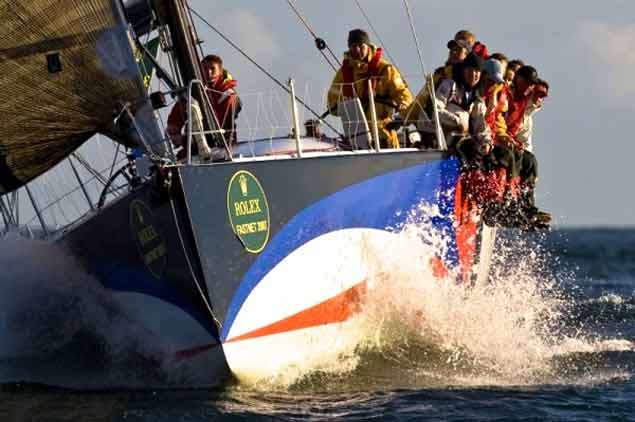 The winner that came out of nowhere…..Chieftain approaching the finish of the Rolex Fastnet Race 2007 on the Tuesday evening
The winner that came out of nowhere…..Chieftain approaching the finish of the Rolex Fastnet Race 2007 on the Tuesday evening
Thus it was something of a surprise when Chieftain appeared on her own out of the late evening light as Thursday night drew on, and finished towards sunset into an unchallengeable winning position. Conditions had ideally suited a boat of her size and type, but there were several comparable craft – it was Chieftain the last-minute entry which had read it to perfection for a very clearcut Irish win, and now Ger O’Rourke had an unexpected problem – he had to hit the shops in Plymouth to find a clean shirt for the prize-giving.
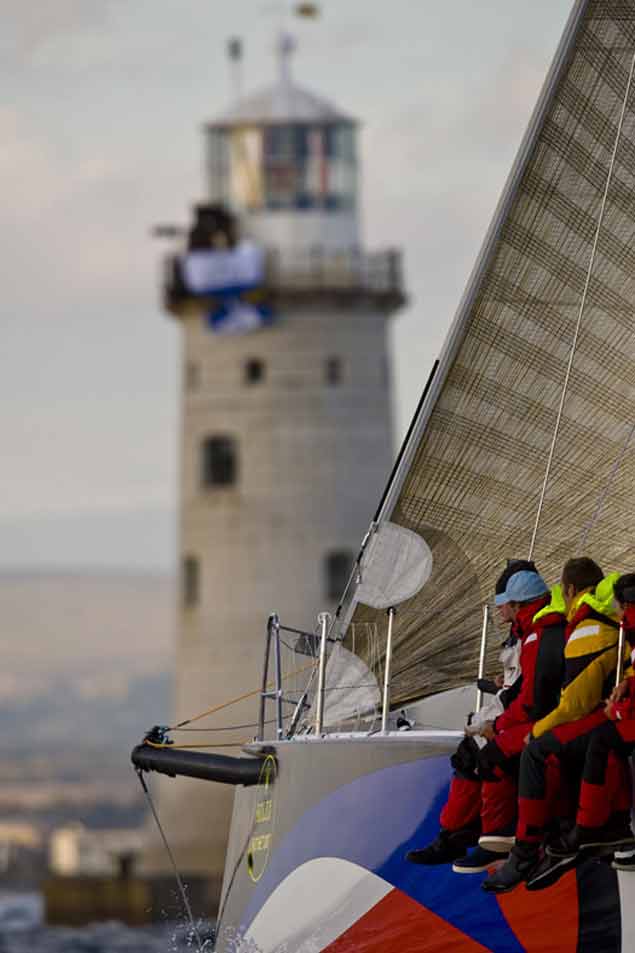 Home before dark – Chieftain and her motley crew cross the finish line at Plymouth to win the Rolex Fastnet Race 2007. Owner/skipper Ger O’Rourke had some unexpected retail therapy in having to buy a clean shirt for the prize-giving
Home before dark – Chieftain and her motley crew cross the finish line at Plymouth to win the Rolex Fastnet Race 2007. Owner/skipper Ger O’Rourke had some unexpected retail therapy in having to buy a clean shirt for the prize-giving
It had been a magnificent win, and in its total individuality, it stands alone. Since then, Irish success in the Fastnet has been for the Roger Justice Trophy for Sailing Schools, with Ronan O Siochru with Irish offshore sailing’s Sunfast 37 Desert Star winning in 2015, while Kenneth Rumball with Irish National Sailing School’s J/109 Jedi won it in 2017.
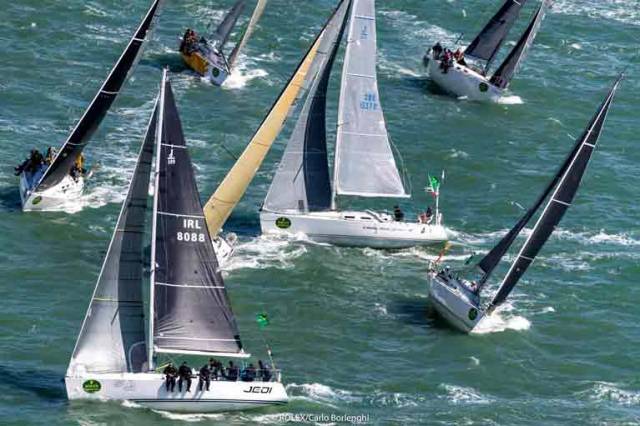 The Irish National Sailing School’s J/109 Jedi (left foreground) makes a neat start to the Rolex Fastnet Race 2017 in which she won the Roger Justice Trophy. Photo Rolex/Carlo Borlenghi
The Irish National Sailing School’s J/109 Jedi (left foreground) makes a neat start to the Rolex Fastnet Race 2017 in which she won the Roger Justice Trophy. Photo Rolex/Carlo Borlenghi
So all in all, it’s a more-than-reasonable record of Fastnet success for Ireland. And anyway, it is our rock, after all, is said and done. So we undoubtedly have skin in the game for 2025’s Centenary, and doubtless, there are several top sailors thinking about it already, though the way the enormous but still limited online entry list is filled within minutes of opening for business makes it a bit of a lottery securing a place.
That said, straightforward priority should be given to boat with a gold standard Fastnet Race history, and it’s particularly notable how many pre-World War II Fastnet Race overall winners are still happily with us, including Bloodhound from 1939, Stormy Weather from 1935, Dorade from 1933 and 1931, and Tally Ho from 1927 which is currently (as reported in Afloat) being restored.
 Still going strong. The beautifully-restored 1931 and 1933 Fastnet Race winner Dorade (left) chasing the 1935 winner Stormy Weather in the race of 2015 – despite being five years older, Dorade finished ahead. Photo: Rolex/Daniel Forster
Still going strong. The beautifully-restored 1931 and 1933 Fastnet Race winner Dorade (left) chasing the 1935 winner Stormy Weather in the race of 2015 – despite being five years older, Dorade finished ahead. Photo: Rolex/Daniel Forster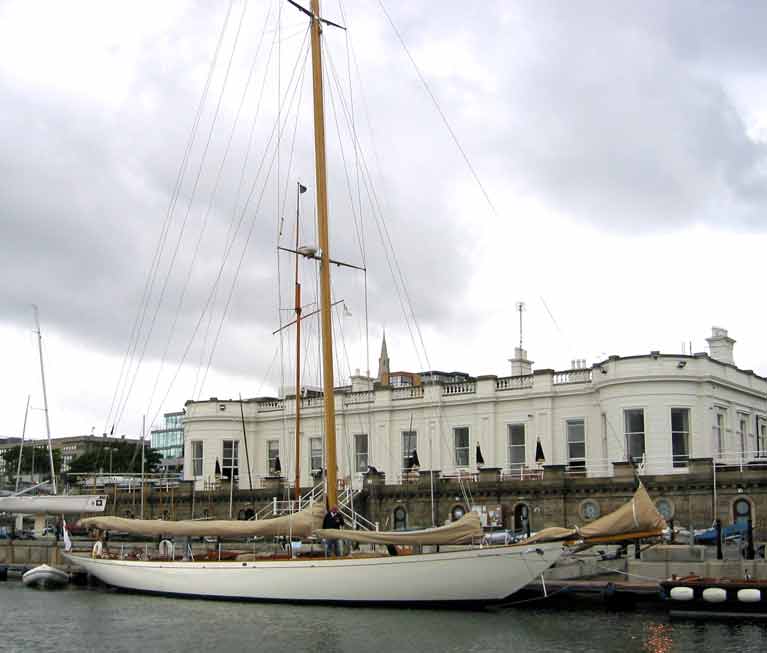 The 70ft Hallowe’en at the Royal Irish YC in Dun Laoghaire. Designed and built by Fife of Fairlie, Hallowe’en won line honours in the 1926 Fastnet Race in her first season afloat. Photo: W M Nixon
The 70ft Hallowe’en at the Royal Irish YC in Dun Laoghaire. Designed and built by Fife of Fairlie, Hallowe’en won line honours in the 1926 Fastnet Race in her first season afloat. Photo: W M Nixon
Also making their stately way afloat are the 1939 line honours winner, the 88ft Nordwind, and the 1926 line honours champion, the Irish-owned 70ft Fife-designed-and-built beauty Hallowe’en. But important as these Fastnet veterans are, for sheer prominence in the race’s history, none can rival the former Pilot Cutter Jolie Brise, winner for George Martin in the first race of 1925 and for Bobby Somerset in 1929 and 1930.
Jolie Brise is reckoned by the pundits to be the finest pilot cutter ever built. And her three successes in the early Fastnets were pointers to the success pattern in the modern race. For Jolie Brise is French-designed, and French-built. She was the last sailing pilot cutter to be commissioned for the vital service out of Le Havre in Normandy. She sails like a witch. Jolie Brise is very special indeed.
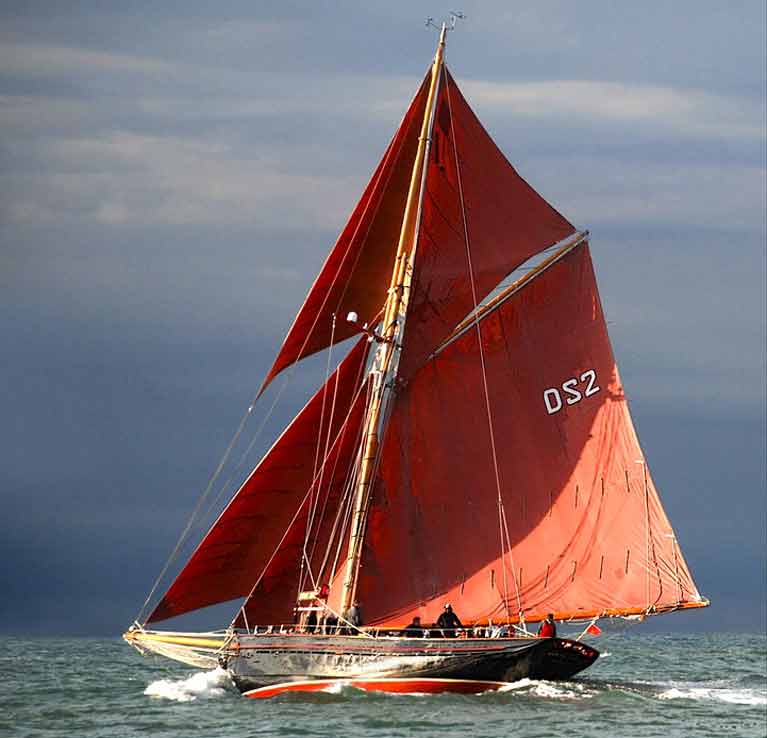 The last (and greatest) of Le Havre’s sailing pilot cutters, Jolie Brise was designed and built in France in 1913, and has won three Fastnet Races including the first one in 1925, plus the races of 1929 and 1930. She is now beautifully maintained and well used by Dauntsey’s School of Wiltshire in England
The last (and greatest) of Le Havre’s sailing pilot cutters, Jolie Brise was designed and built in France in 1913, and has won three Fastnet Races including the first one in 1925, plus the races of 1929 and 1930. She is now beautifully maintained and well used by Dauntsey’s School of Wiltshire in England
Irish Success in the Fastnet Race
- 1925 Gull (HPF Donegan, Royal Cork YC) 3rd overall
- 1926 Hallowe’en (now owned by Royal Irish YC syndicate) First to finish
- 1947 Aideen (A.W. Mooney, Irish Cruising Club) First in Class A
- 1947 Marama (Harald Osterberg, ICC) Second Class A
- 1953 Glance (F & E Hopkirk, Royal Ulster YC) 1st Div A, Jolie Brise Cup
- 1971 Clarion of Wight (Dr Rory O’Hanlon, Irish CC & Royal St George YC) First Division A and Philip Whitehead Cup
- 1971 Setanta of Skerries (Ronnie Wayte, Irish Cr C & Skerries SC) Second Class IV
- 1981 Regardless (Ken Rohan, Royal Irish YC) First Class 1
- 1987 Irish independent/Full Pelt (Tom Power & Stephen Fein, Royal Irish YC) First overall
- 1987 Imp (Roy Dickson, Howth YC) 1st Div A, Philip Whitehead Cup
- 2005 Cavatina (Eric Lisson, Royal Cork YC) 2nd Overall and 2nd Class 3
- 2007 Chieftain (Ger O’Rourke, Royal Western of Ireland YC) First overall and Fastnet Challenge Cup, RORC Yacht of the Year 2007)
- 2007 Cavatina (Eric Lisson, RCYC) First Class 3
- 2015 Desert Star (Ronan O Siochru, Irish Offshore Sailing) Roger Justice Trophy
- 2017 Jedi (Kenneth Rumball, Irish National SS) Roger Justice Trophy
*Afloat.ie welcomes any additions and corrections to the above
Restoring the 1910 Cutter 'Tally Ho' for Another Fastnet Race
The ongoing restoration of the historic cutter Tally Ho by the intrepid Leo Goolden in Washington State, USA is a sight to behold on youtube writes Pete Hogan.
To those who have not chanced upon his wonderful series of videos (scroll down for one), now numbering over 50 episodes, I highly recommend them as suitable for viewing these long winter nights.
Leo Sampson Goolden is a Boatbuilder, Sailor and Writer from Bristol. He restored a 1947 Folkboat and sailed it, without lifelines, engine, or GPS, across the Atlantic in 2014. From there, as many boat bums do, he got a job on big classic sailing boats which paid well and showed him a different side of the yachting world.
 Leo (above) and below on the folkboat
Leo (above) and below on the folkboat

Then in what must have been a eureka moment, Leo bought, from The Albert Strange Association, the 48-foot gaff cutter Tally Ho (for £1 as she was in need of complete restoration and also had to be moved). Tally Ho, dating from 1910, designed by Albert Strange, won the 1927 Fastnet race, one of only two yachts from the fifteen starters to complete the race. She ended up in the Pacific as a workboat and was pretty well derelict.
The project is not unlike the recent restoration of the Ilen here in Ireland, and the vessels are of similar size. But Leo is doing it all on his own, depending on volunteer help and public donations of money and equipment. Central to this business plan is the making of videos to publicize the project. He’s a young guy, (my guess is about 30), and everything is happening in front of the cameras. He is visibly maturing and gaining in confidence over the plus 25 hours of footage which is now on view. It was heart-breaking to see him admit in one episode that he had cut the top off one of his fingers. His ardent fans are eager to see what happens to the girl who appears every now and then. Watching over all is a cute parrot.
 A watercolour of Tally Ho at the Fastnet Rock by article author Pete Hogan
A watercolour of Tally Ho at the Fastnet Rock by article author Pete Hogan
There are many, indeed countless, restoration, adventure, misfortune, quirky, yachting videos online but I can confidently say that Leo’s series, for interest, humour, technical detail, longevity, and courage, beats them all. It’s hard to say, but about two years in, the project is about halfway to completion and the aim is to sail Tally Ho in a Fastnet Race again.
To follow Leo and the restoration of Tally Ho click here
RORC ‘Might Consider’ Plymouth For Fastnet Race Finish In 2025
Organisers of the Rolex Fastnet Race have citied “infrastructre” issues in their decision to move the finish of the 2021 and 2023 races from Plymouth to Cherbourg.
And in a press conference announcing the move this afternoon (Tuesday 26 November), the Royal Ocean Racing Club said it “might consider” the traditional host city for the 100th anniversary of the offshore race in 2025.
“We place considerable value on the traditions of the race, and we respect Plymouth’s association with the race history, and indeed the formation of this club,” said RORC Commodore Steven Anderson.
“But we don’t believe that this should restrict the ability of the race to develop and to satisfy the demand there is for people to compete in the race.
“We have been working closely throughout this year with Plymouth City Council and we very much appreciate all they did for us this year in the 2019 edition.
“Plymouth are developing some plans for infrastructure and if and when they come to fruition, that would be something that we might consider for the 100th anniversary in 2025, and we will continue to work with them during that time.”
As reported earlier on Afloat.ie, the RORC announced that the French city of Cherbourg on the English Channel will host the finish of the biennial race’s next two editions — a move the organisers say encourages and secures the future development of a race that had a waiting list of 150 boats for this year’s running.
Rumours that Plymouth might lose its traditional hosting of the Fastnet Race began circulating over year ago.
More recently, the Devon coastal city lost its hosting of The Transat to France, with Brest set to host the start of the 60th anniversary of the four-yearly race next year.
Fastnet Race to Finish in Cherbourg, RORC Announce
The Royal Ocean Racing Club (RORC), organisers of the Rolex Fastnet Race, announced at a press conference today that the City of Cherbourg will host the finish of the Rolex Fastnet Race for the 2021 and 2023 editions of the biennial race. The move encourages and secures the future development of the race and will open it to more competitors; in 2019 the race had a waiting list of 150 boats.
Details of the announcement were made online today in a Facebook Live broadcast that attracted 254 viewers, as Afloat reported earlier here.
In his announcement, RORC Commodore Steven Anderson said he would consider returning to the previous finish city of Plymouth for 2025, for the 100th edition of the race, if facilities can be extended.
The new course will be 90 nautical miles longer and RORC say there is no decision yet on whether or not it will run before or after Cowes Week in 2021.
Rumours of the move to France first surfaced a year ago and were reported by Afloat here. And in September 2018, Afloat's WM Nixon blogged: Is This The Beginning Of The End Of The Fastnet Race As We Know It?
Online comments were swift and not altogether positive: Gareth Evans stating the Fastnet is "a British Tradition and British Race" and that it should really finish in Great Britain. Facebook Live Viewer Adrian Gray stated that it was 'stomach-churning' and that '96% are against this change'. Paul Browning said it was 'Terrible news. Sell out of the many for the vested interest of the elite'. But Fiona Tully remarked online: 'I can understand why they are moving it..... To facilitate the ever-growing demand for sailors that want to compete in this historic race and Plymouth perhaps just does not have the infrastructure or facilities for this demand'. Chris Shipman said: 'Fantastic idea and great to share this event with the French who are such prominent participants in the Fastnet race".
Others like Paul Cunningham said 'A precedent has now been set, that the race finish can be moved to anywhere that is approximately 600+ NM from Cowes after rounding the Fastnet Rock'. Kenneth Sharp commented 'That’s a long sail back for Irish yachts!'. Nick Barlow said that 'given the additional distance it will definitely favour the larger boats. This supports the need for a Corinthian Fastnet run by JOG and Plymouth clubs'.
The City of Cherbourg-en-Cotentin, The Communauté d’agglomération du Cotentin, the Conseil départemental de la Manche and Normandy Region have come together to support the race finish with a package that enhances the competitor experience with increased berthing, enhanced shoreside facilities, competitor functions and events in an exciting development for the race.
Since seven boats competed in the first race in 1925, the Royal Ocean Racing Club has continued to push the boundaries of participation in offshore racing. The 2019 Rolex Fastnet Race had 388 yachts on the start line from 27 different nations. The Club’s aim is to foster greater participation and improve access to the race. The enhanced facilities offered by Cherbourg will give the opportunity for more boats and sailors to take part in the Rolex Fastnet Race in future years.
Speaking about the benefits of Cherbourg as the finish venue, RORC Commodore, Steven Anderson, said: “It is an exciting time for this iconic and extremely successful race. Finishing the Rolex Fastnet Race in Cherbourg will encourage and secure the continued growth of the Club’s most prestigious event and provide an enhanced competitor experience. The enthusiasm of the French for offshore racing is legendary, and the City of Cherbourg-en-Cotentin, The Communauté d’agglomération du Cotentin, the Conseil départemental de la Manche and Normandy Region have been hugely passionate and committed partners in this initiative.”
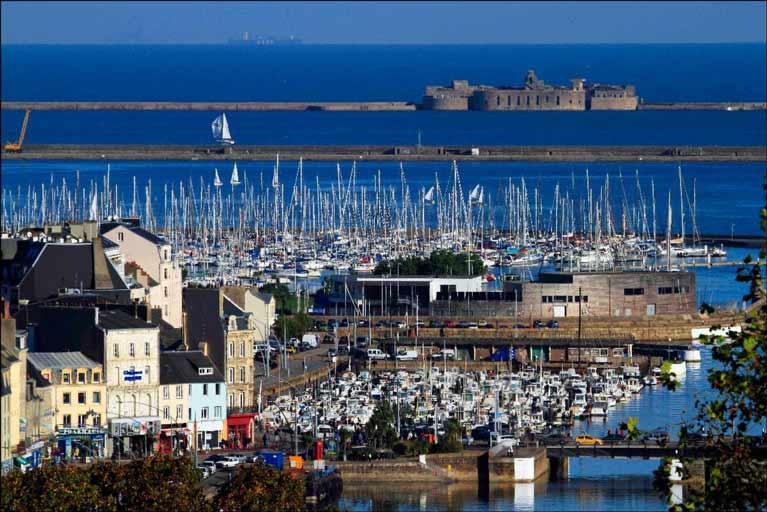 The City of Cherbourg will host the finish of the Rolex Fastnet Race in 2021 and 2023 Photo: JM Enault /Ville de Cherbourg en Cotentin
The City of Cherbourg will host the finish of the Rolex Fastnet Race in 2021 and 2023 Photo: JM Enault /Ville de Cherbourg en Cotentin
“The race has grown steadily over the past two decades and more and more people want to take part. We have had to limit entries in recent years because of berthing constraints, but Cherbourg offers significant additional berthing and improved facilities for competitors, so we will be able to take a larger number of entries and give more sailors the opportunity to compete in this very special race,” continued Anderson.
Jean-Louis Valentin, President of La Communauté d’agglomération du Cotentin said: “Cherbourg is one of France’s great channel ports, closely linked to naval history and transatlantic adventures, and the Cotentin Coast is home to the many prominent water sports events. Bringing the Rolex Fastnet Race finish to Cherbourg means that the City and Cotentin are now part of the club of coastal territories linked to a mythical offshore race. The adventure of a great race, sailors in the City and beautiful entertainment, will make the finish a popular ocean racing spectacle for the public. A Race Village and many festivities have already been planned in Cherbourg-en-Cotentin to invite Normans and sailing enthusiasts to take part in this great ocean festival.”
RORC CEO, Eddie Warden Owen commented: “This is an exciting chapter in the history of the Fastnet Race and the founding fathers who competed in the very first race in 1925 will be proud that the race has survived all these years and seen unprecedented growth. City of Cherbourg-en-Cotentin, The Communauté d’agglomération du Cotentin, the Conseil départemental de la Manche and Normandy Region will give the sailors a warm welcome. The French are known for their passion for offshore racing and French sailors regularly compete in and have won the Rolex Fastnet Race. This is exciting times for the Royal Ocean Racing Club and the Rolex Fastnet Race as we continue to evolve and expand for the benefit of our members and offshore racing sailors worldwide.”
Benoît Arrive, Mayor of Cherbourg-en-Contentin said: “Our City has a long history with the Royal Ocean Racing Club. Many sailors from Cherbourg-en-Cotentin have competed in the legendary Fastnet Race and for many of them, the RORC Season’s Points Championship remains a major competition. Several Cherbourgers have distinguished themselves in the Fastnet Race, Alexis Lioisin in particular, a recent double winner with his father. The Solent is not far from our port and I am very happy that we can bring them together by hosting this very important sailing event for the first time. Our port is used to hosting major sailing events and is looking forward to being the arrival city for the next two editions. 2021 and 2023 will be exceptional for the Rolex Fastnet Race.”
RORC To Make 'Major Fastnet Race Announcement' Today
The Royal Ocean Racing Club (RORC) is heralding big changes to its world's largest offshore race, the Rolex Fastnet Race at lunchtime today.
The offshore club has invited members of the press to a Briefing concerning the world's largest offshore race, at its London clubhouse where a 'major announcement' will be made.
The announcement will be broadcast Live on Facebook at 13.30. Visit: www.facebook.com/royaloceanracingclub


